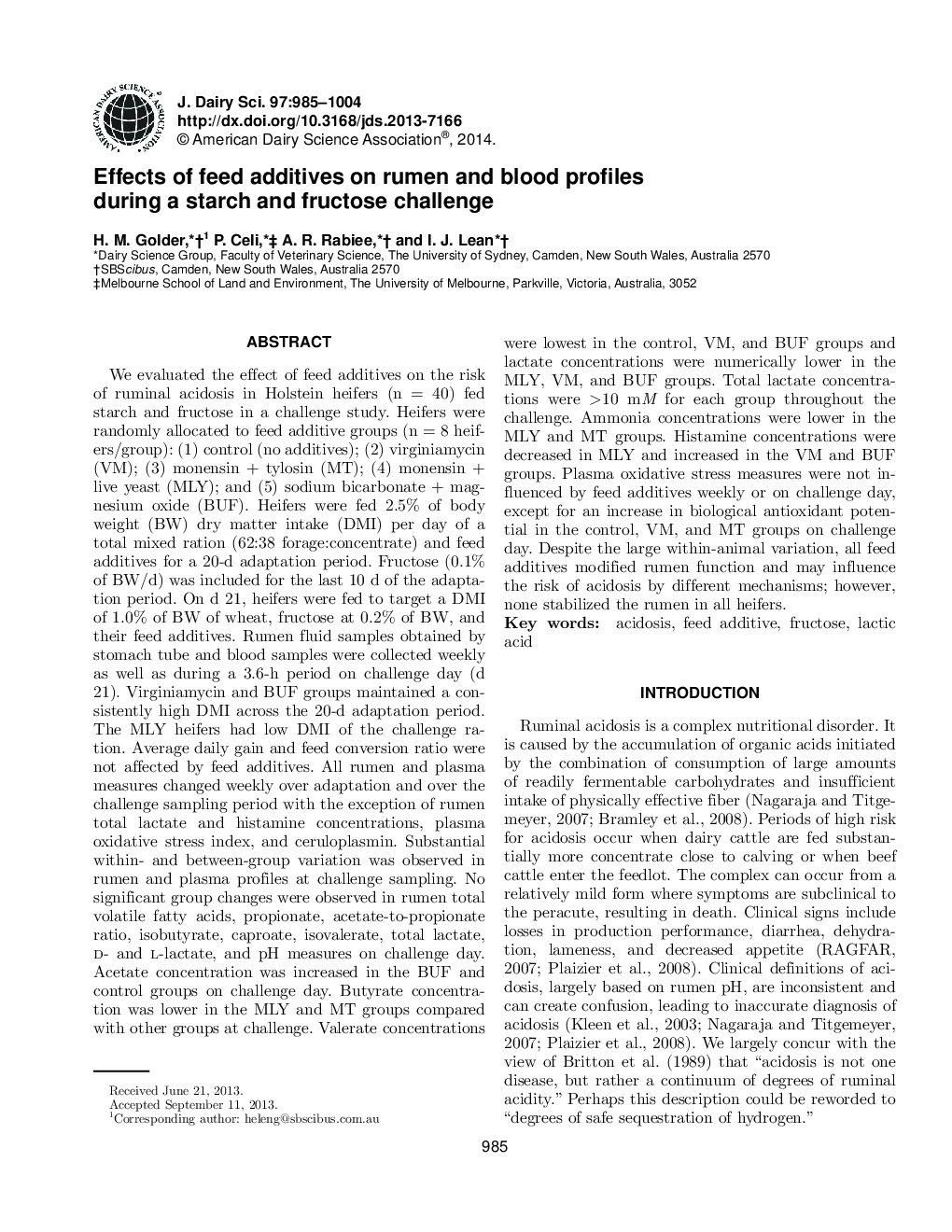| کد مقاله | کد نشریه | سال انتشار | مقاله انگلیسی | نسخه تمام متن |
|---|---|---|---|---|
| 10977056 | 1108046 | 2014 | 20 صفحه PDF | دانلود رایگان |
عنوان انگلیسی مقاله ISI
Effects of feed additives on rumen and blood profiles during a starch and fructose challenge
ترجمه فارسی عنوان
تأثیر مواد افزودنی خوراکی بر پروتئین های شکمبه و خون در طی چالش نشاسته و فروکتوز
دانلود مقاله + سفارش ترجمه
دانلود مقاله ISI انگلیسی
رایگان برای ایرانیان
کلمات کلیدی
اسیدوز، افزودنی خوراکی، فروکتوز، اسید لاکتیک،
موضوعات مرتبط
علوم زیستی و بیوفناوری
علوم کشاورزی و بیولوژیک
علوم دامی و جانورشناسی
چکیده انگلیسی
We evaluated the effect of feed additives on the risk of ruminal acidosis in Holstein heifers (n = 40) fed starch and fructose in a challenge study. Heifers were randomly allocated to feed additive groups (n = 8 heifers/group): (1) control (no additives); (2) virginiamycin (VM); (3) monensin + tylosin (MT); (4) monensin + live yeast (MLY); and (5) sodium bicarbonate + magnesium oxide (BUF). Heifers were fed 2.5% of body weight (BW) dry matter intake (DMI) per day of a total mixed ration (62:38 forage:concentrate) and feed additives for a 20-d adaptation period. Fructose (0.1% of BW/d) was included for the last 10 d of the adaptation period. On d 21, heifers were fed to target a DMI of 1.0% of BW of wheat, fructose at 0.2% of BW, and their feed additives. Rumen fluid samples obtained by stomach tube and blood samples were collected weekly as well as during a 3.6-h period on challenge day (d 21). Virginiamycin and BUF groups maintained a consistently high DMI across the 20-d adaptation period. The MLY heifers had low DMI of the challenge ration. Average daily gain and feed conversion ratio were not affected by feed additives. All rumen and plasma measures changed weekly over adaptation and over the challenge sampling period with the exception of rumen total lactate and histamine concentrations, plasma oxidative stress index, and ceruloplasmin. Substantial within- and between-group variation was observed in rumen and plasma profiles at challenge sampling. No significant group changes were observed in rumen total volatile fatty acids, propionate, acetate-to-propionate ratio, isobutyrate, caproate, isovalerate, total lactate, d- and l-lactate, and pH measures on challenge day. Acetate concentration was increased in the BUF and control groups on challenge day. Butyrate concentration was lower in the MLY and MT groups compared with other groups at challenge. Valerate concentrations were lowest in the control, VM, and BUF groups and lactate concentrations were numerically lower in the MLY, VM, and BUF groups. Total lactate concentrations were >10 mM for each group throughout the challenge. Ammonia concentrations were lower in the MLY and MT groups. Histamine concentrations were decreased in MLY and increased in the VM and BUF groups. Plasma oxidative stress measures were not influenced by feed additives weekly or on challenge day, except for an increase in biological antioxidant potential in the control, VM, and MT groups on challenge day. Despite the large within-animal variation, all feed additives modified rumen function and may influence the risk of acidosis by different mechanisms; however, none stabilized the rumen in all heifers.
ناشر
Database: Elsevier - ScienceDirect (ساینس دایرکت)
Journal: Journal of Dairy Science - Volume 97, Issue 2, February 2014, Pages 985-1004
Journal: Journal of Dairy Science - Volume 97, Issue 2, February 2014, Pages 985-1004
نویسندگان
H.M. Golder, P. Celi, A.R. Rabiee, I.J. Lean,
